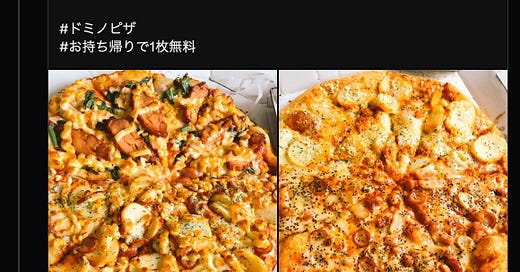This is How to Japanese, a monthly newsletter with something about Japan/Japanese and a dash of いろいろ.
日本・日本語: Here
There’s a recent viral TikTok from Bryan Nothling about the colors of the multiplication tables:
Bryan went super viral for his hoisin sauce dance back in May, but this new video has surpassed that with over 7.8 million views and 1.2 million likes, by far his most popular video. And I think it’s pretty clear why. He manages to put into words the faint synesthesia we all have, to some extent. Numbers have subtle nuances that we don’t always consciously notice.
Words do as well, and I was reminded of this at my last job when I got an email from a Japanese colleague. His response was delayed, so he apologized, as is standard, but something set off my Spidey senses.
I don’t have the exact wording because I received the message on a work account I no longer have access to, but it looked something like this:
返事が遅れてスミマセン。
I’m sorry my reply is late.
Does anything stand out to you? I imagine it’s immediately obvious. The すみません (sumimasen, excuse me/sorry) that would normally be written in hiragana is given in katakana. My immediate impression was that the katakana were emphatic, that he was trying to highlight the degree to which he was sorry for his late reply by having the characters of his writing literally stiffen.
And I think this is probably correct to a certain extent. You see this similarly with ホントにありがとうございます (which gets 298,000 hits on Google as of the time of writing). Using katakana in place of 本当に (hontō ni, really/honestly/very) helps draw attention to the adverb.
Domino’s Japan demonstrates this pretty clearly on their social media, using the phrase in a RT and a reply:
Interestingly, ホントウにありがとうございます only gets 4,330 hits on Google, which also speaks to the visual nature of language. ホントに is, by far, much more aesthetically appealing than ホントウに. It perhaps also more accurately conveys what’s actually being said. Although, in hiragana, ほんとに gets 598,000 results, and ほんとうに 464,000, so maybe it is more visual. But back to the initial topic…
I was curious to confirm katakana used as emphasis with Japanese sources, and when I started Googling around, I found this super interesting paper “The Current State of Katakana Usage in Modern Japanese and Its Background” (現代日本語におけるカタカナ使用の実態とその背景) (PDF) by Hitomi Masuji. (English translation of the title is my own.) The paper is extremely wide ranging, and Masuji’s goal is to examine previously unexplored materials to elicit how katakana is being used.
The specific phenomenon mentioned above is called 非外来語のカタカナ表記 (non-gairaigo katakana notation), which is just what it sounds like: using katakana to write words that are not foreign-derived words. In other words, using katakana to write words that are generally written in kanji or hiragana.
Masuji delves into TV programs, commercials/ads, work emails, product packaging, traffic notices, and academic journals to examine how and why Japanese users choose katakana instead of hiragana or kanji. She divides the reasons broadly into linguistic and non-linguistic reasons. The main linguistic reason seems to be 埋没回避 (maibotsu kaihi, avoiding being absorbed), which is when a word is written in katakana to distinguish it from surrounding words. This prevents a kanji word from getting lost in a sea of other kanji, and likewise with a hiragana word.
We’re interested in the non-linguistic reasons here, which includes what she labels コンテクスト (context). One of those contexts is business relationships, specifically adjusting politeness levels in communication. Masuji examines the use of ヨロシク and スミマセン in business emails and finds that people shift from hiragana to katakana as a “positive politeness strategy,” as a way to apologize or to mitigate the burden of a request.
Fascinating. So the katakana in スミマセン are not purely emphasis, but they do serve to emphasize the apology as a politeness strategy. It’s taking into account how the recipient will view the language visually when they read it. Masuji refers to the usage here as ニュアンスの微調整 (fine tuning the nuance).
I’d recommend using this as a strategy to give your own communication added nuance, but I should pass on Masuji’s own words of warning:
However, it’s important to note that this strategy of using non-gairaigo katakana notation can’t be used for every person you talk to. For example, it isn’t used when addressing people outside one’s company. It’s also difficult to use when addressing those senior to oneself. Using it involves the distance/power dynamics with others. In addition, there are restrictions on the situations when this strategy can be used. The purpose and content—in other words, the degree of the burden being placed on the person being addressed—affect whether it can be used.
ただし、この非外来語のカタカナ表記を用いたストラテジーが、どのような相手に対しても使用されるわけではないことに注意しなければならない。例えば、社外の人に対しては使用されない。目上の人に対しても、使用されにくい。相手との距離・力関係が関わってくるのである。また、このストラテジーが使用される場にも制限がある。目的や内容、つまり相手にかける負担の度合いによっても使用されるか否かが左右される。(80-81)
Reserve this strategy for people within your own company on the same level as you. It’s a useful way to fine tune your politeness and emphasize the fact that you’re collaborators. Out in the world, not at a company, I imagine you could also effectively use katakana this way with people who are your social peers.
Check out the full PDF if you’re interested in learning more. At the very end, she includes a full chart of all the words used, the number of times they were used, and which media they appeared in.
Words and language are so everyday and ever-present that sometimes we (or at least I) forget that the visual representation of language is secondary. Language exists independent of the writing system. Using katakana this way is a nice reminder that we can use the writing system to capture so much, even extra-linguistic aspects of communication.
Check out the podcast this month for more!
いろいろ
As previewed in last month’s newsletter, Asahi released a session strength version of their ubiquitous Super Dry. It’s called Dry Crystal, and it rings in at 3.5%. It’s not bad! The more you drink it, the closer it tastes to regular Super Dry, ha. It’s not quite as good as the original, but I appreciate a session strength beer. I’m just confused why they decided to release it in October and not August. You can drink this beer forever, and it would fit in well during the hot summer months. My best guess is that beer sales naturally increase during the summer in Japan, so maybe Asahi needed some kind of novelty to drive demand during the off season.
Or perhaps it was related to changing alcohol tax laws? Tax on beer fell this month as part of a changes in the law that will bring beer and 発泡酒 (happōshu)/non-beers closer together over the next few years. Taxes on the latter went up.
Christmas creep has begun in Japan.
Matt Alt has a great interview with Murakami translator Alfred Birnbaum in his newsletter. Matt includes so many great details about his life as a child in Japan, working with Murakami, and translating. What a cool piece and a great addition to Murakami's history.










